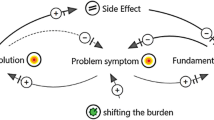Abstract
Structuring and exploring complex problems is still one of the most significant challenges in strategic decision-making and management. On the one hand, we strive to add as much rigor as possible to the analyses made, for example, through simulation models or data analyses. On the other hand, we need to stay connected with all kinds of stakeholders - an essential precondition for implementation.
Following up on our earlier research, we present an approach that combines narratives, Causal Loop Diagrams, and Behavior-Over-Time Graphs to illustrate the structure, dynamic patterns and quantitative scale of the problem under study step-by-step, allowing exploration and reflection by a broad audience.
Access this chapter
Tax calculation will be finalised at checkout
Purchases are for personal use only
Similar content being viewed by others
Notes
- 1.
Detailed instructions about how we can elicit BOTGs and CLDs in workshop settings can be found on Scriptapedia; https://en.wikibooks.org/wiki/Scriptapedia.
- 2.
We described some underlying ideas in [8]. We host the code open-source on GitHub. https://github.com/ims-fhs/cld.
- 3.
Among them are i) a project funded by the Swiss National Science Foundation about psychosocial risks at work; ii) a project funded by Innosuisse - Swiss Innovation Agency aiming at improving ambulant mobile psychotherapy; and iii) a project about common work-life-balance conflicts funded by the Swiss Federal Office for Gender Equality.
- 4.
See [8] for details about the DSL grammar and import options.
- 5.
Defined curve segments are: straight lines (%-%), upward (%(%) and downward (%)%) bent segments, and s-curves (%s%). Details in code documentation.
- 6.
An example of a complete narrative is accessible at https://fhsg.shinyapps.io/burnout/.
References
Forrester, J.W.: Industrial dynamics (1961)
Sterman, J.D.: Learning in and about complex systems. Syst. Dyn. Rev. 10(2–3), 291–330 (1994)
Vennix, J.A.M.: Group model-building: tackling messy problems. Syst. Dyn. Rev. 15(4), 379–401 (1999)
Hovmand, P.S.: Community based system dynamics (2014)
Wolstenholme, E.F.: Qualitative vs quantitative modelling: the evolving balance. J. Oper. Res. Soc. 50(4), 422–428 (1999)
Black, L.J., Andersen, D.F.: Using visual representations as boundary objects to resolve conflict in collaborative model-building approaches. Syst. Res. Behav. Sci. 29, 194–208 (2012)
Schon, D.A.: Generative metaphor and social policy. In: Metaphor and Thought (1979)
Stämpfli, A.: A domain-specific language to process causal loop diagrams with R. In: Neufeld, J.S., Buscher, U., Lasch, R., Möst, D., Schönberger, J. (eds.) Operations Research Proceedings 2019. ORP, pp. 651–657. Springer, Cham (2020). https://doi.org/10.1007/978-3-030-48439-2_79
Homer, J.B.: Worker burnout: a dynamic model with implications for prevention and control. Syst. Dyn. Rev. 1(1), 42–62 (1985)
Paulus, S.: Gefährdungsbeurteilungen von psychosozialen Risiken in der Arbeitswelt. Zum Stand der Forschung. Zeitschrift für Arbeitswissenschaft 73(2), 141–152 (2018)
Author information
Authors and Affiliations
Corresponding author
Editor information
Editors and Affiliations
Rights and permissions
Copyright information
© 2022 The Author(s), under exclusive license to Springer Nature Switzerland AG
About this paper
Cite this paper
Stämpfli, A. (2022). Combining Causal Loop Diagrams, Behavior-Over-Time Graphs, and Narratives to Structure and Explore Complex Decision-Making Situations. In: Trautmann, N., Gnägi, M. (eds) Operations Research Proceedings 2021. OR 2021. Lecture Notes in Operations Research. Springer, Cham. https://doi.org/10.1007/978-3-031-08623-6_63
Download citation
DOI: https://doi.org/10.1007/978-3-031-08623-6_63
Published:
Publisher Name: Springer, Cham
Print ISBN: 978-3-031-08622-9
Online ISBN: 978-3-031-08623-6
eBook Packages: Business and ManagementBusiness and Management (R0)




